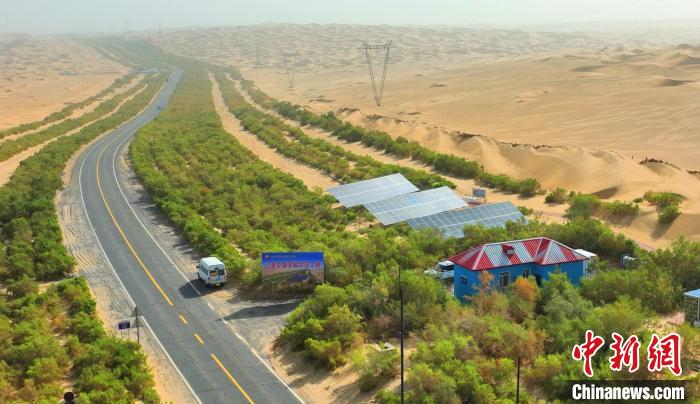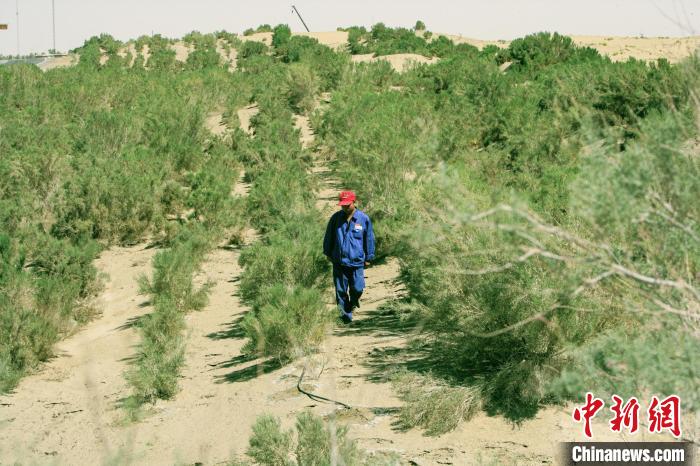How can the Tarim Desert Highway create a new dimension of "zero carbon"?
Zhongxin. ComUrumqi, June 25 (Tao Shuanke and Wang Chengkai) Walking through the Tarim Desert Highway, the vegetation on both sides of the road is full of green. From time to time, photovoltaic power generation panels are scattered among them, using "light energy" to irrigate the vegetation along the route, becoming a "new attraction" in the desert.
From the entire line of desert roads to the lush greenery of ecological protective forests; from diesel power generation and pumping irrigation to the use of sunlight to "green" the desert, the "zero carbon" demonstration project of the Tarim Desert Highway built by Tarim Oilfield has achieved desertification control and environmental protection. The dual effect.
Take the lead in planning "zero carbon" actions
The Tarim Desert Highway was completed and opened to traffic in 1995, with a total length of about 566 kilometers. It is the world's longest grade highway running through a mobile desert and the earliest desert highway in China. The completion of the highway not only solved the transportation problem of exploring and developing oil deep into the desert hinterland, but also opened up the traffic barrier between the north and south of the Tarim Basin, shortening the distance from Hotan Prefecture to Urumqi by more than 500 kilometers.
In order to resist the invasion of sand and sand on roads, the Tarim Desert Highway Shelter Forest Ecological Project with a total investment of 220 million yuan started construction in 2003 and was fully completed in April 2006. Oil workers in the Tarim Oilfield planted protective forest belts on both sides of the desert highway, and set up 109 water wells along the forest belts to pump water and irrigate, allowing more than 20 million drought-resistant and alkali-resistant psamic plants to take root deeply.
In 2022, the Tarim Desert Highway "Zero Carbon" demonstration project will be put into operation. Since then, the desert highway ecological protective forest pumping irrigation "oil-to-electricity" has zero carbon emissions, becoming China's first "zero-carbon" desert highway.
Today, two years later, desert roads are adjacent to fragrant grass and beautiful scenery, becoming a "zero-carbon sample" of harmonious coexistence between man and nature.

The ecological protective forest on both sides of the desert road is like a green artery that winds into the distance. Tarim Oilfield Map
Xu Bo, who once worked in the land management post of the Tazhong Oil and Gas Management Zone of the Tarim Oilfield, said: "Once upon a time, oil workers planted protective forest belts in the desert. Today, more than 20 million Haloxylon ammodendron, red willow and other salt-alkali and drought-tolerant plants have not only taken root here, but also absorbed greener 'nutrition'."
In 2021, the Tarim Desert Highway will be listed on the "Most Beautiful Highway in China" list-the most beautiful highway in the oasis desert area. Du Yousheng, a driver who drives through the desert all year round, is deeply touched: "When encountering a sandstorm on the road, as long as you drive into this protective forest, the eye-catching sand will be forced back."
Desert roads become green and low-carbon "new sample"
In recent years, Tarim Oilfield, as a builder of desert roads, has accelerated the implementation of green expansion and carbon reduction measures, and has carried out photovoltaic transformation of water wells along the line. During this period, technicians successively designed photovoltaic power generation equipment with three powers, and also adopted photovoltaic and energy storage methods to ensure that the pumping equipment can operate normally without sunlight.
The total installed capacity of the newly built photovoltaic power station on the desert highway exceeds 3800 kilowatts, and the average annual output of green electricity is nearly 4 million kilowatt hours, fully meeting the daily irrigation needs of the 436-kilometer-long ecological protective forest.
The economic benefits brought by energy conservation and carbon reduction are "eye-catching". Since photovoltaic power generation, ecological protective forests can absorb about 20,000 tons of carbon dioxide every year, and the negative carbon part can neutralize the carbon emissions of passing vehicles. It provides a "Tarim Plan" for China's desert management and desert road operation and maintenance, and has embarked on a new photovoltaic desertification control path.
Over the years, the average height of 47,000 acres of green vegetation on both sides of the desert road has exceeded 2 meters. Elaeagnus angustifolia trees, Haloxylon ammodendron, red willow, etc. are lush, and more than 100 species of birds have inhabit here. Wild animals such as hares, gerbils, and sand foxes have settled here, and an ecological environment has gradually taken shape.
Desert highway ecology achieves a virtuous cycle
With the innovation of photovoltaic power generation irrigation technology in Tarim Oilfield, the economic value and social benefits of this desert highway are constantly emerging.
The desert road protected by the "Green Corridor" withstands the invasion of sandstorms. It is precisely because of this highway that 32 large and medium-sized oil and gas fields in Tarim have mushroomed rapidly in the hinterland of the desert and surrounding areas, and abundant oil and natural gas are gushing out from the hinterland of the desert.

Ecological protective forest for Tarim Desert Highway. Tarim Oilfield Map
In 2023, the oil and gas output of Tarim Oilfield will remain above 30 million tons for the fourth consecutive year, becoming one of the main gas sources for the West-East Gas Pipeline.
Up to now, Tarim Oilfield has built four photovoltaic power stations with a total installed capacity of 1.3 million kilowatts in the hinterland and surrounding areas of the Taklimakan Desert, and all have achieved full-capacity grid-connected power generation, and a total of more than 700 million kilowatt-hours of green electricity has been produced.
In addition, the Tarim Oilfield has also promoted the construction of biodiversity demonstration zones according to local conditions, building 64,000 acres of artificial oases in the hinterland of the Taklimakan Desert and its surrounding areas, effectively protecting the fragile ecological environment of the Tarim Basin.







